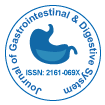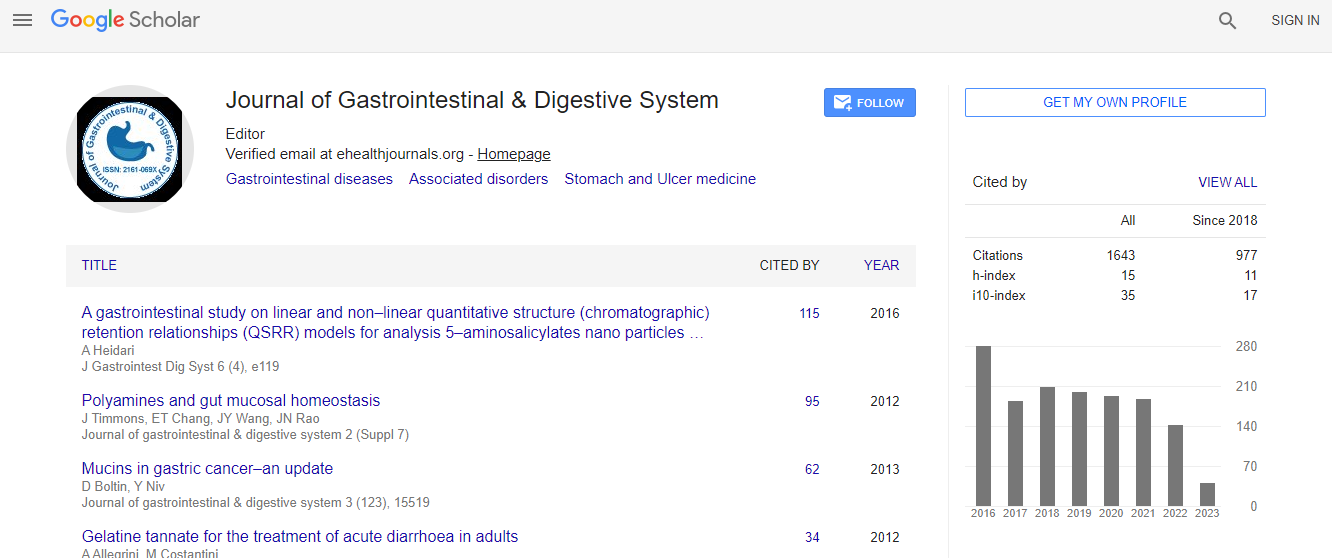Our Group organises 3000+ Global Conferenceseries Events every year across USA, Europe & Asia with support from 1000 more scientific Societies and Publishes 700+ Open Access Journals which contains over 50000 eminent personalities, reputed scientists as editorial board members.
Open Access Journals gaining more Readers and Citations
700 Journals and 15,000,000 Readers Each Journal is getting 25,000+ Readers
Google Scholar citation report
Citations : 2091
Journal of Gastrointestinal & Digestive System received 2091 citations as per Google Scholar report
Journal of Gastrointestinal & Digestive System peer review process verified at publons
Indexed In
- Index Copernicus
- Google Scholar
- Sherpa Romeo
- Open J Gate
- Genamics JournalSeek
- China National Knowledge Infrastructure (CNKI)
- Electronic Journals Library
- RefSeek
- Hamdard University
- EBSCO A-Z
- OCLC- WorldCat
- SWB online catalog
- Virtual Library of Biology (vifabio)
- Publons
- Geneva Foundation for Medical Education and Research
- Euro Pub
- ICMJE
Useful Links
Recommended Journals
Related Subjects
Share This Page
Microvillous inclusion disease: What did we know so far
14th Annual Congress on Gastroenterology & Hepatology
Badr Al-Saleem
King Fahad Medical City, KSA
Posters & Accepted Abstracts: J Gastrointest Dig Syst
Abstract
Microvillous inclusion disease or microvillous atrophy is a rare congenital autosomal recessive disorder of the intestinal epithelial cells that presents with persistent life-threatening secretory watery diarrhea. MVID manifests either in the first days of life (early-onset form) or in the first few weeks of life (late-onset form). MVID is associated with consanguinity and arises mainly in the Middle East. All patients were from consanguineous families (from our study not yet published). The onset of diarrhea was in early neonatal period in all patients. One patient was weaned off PN. One patient underwent SBTx. Four patients are PN dependent and four died between (4 months-7 years of age). Different MYO5B mutations were detected in 8 families and a homozygous mutation in STX 3 gene was identified in one patient. Muller, et al. 2008 identified homozygous and compound heterozygous nonsense and missense mutations in MYO5B, encoding type-Vb myosin motor protein. Several studies have added to the understanding of pathophysiology of MVID by showing that MYO5B mutations were associated with disrupted epithelial cell polarity indicating that MYO5B gene has a role in the regulation of intracellular protein trafficking. These findings might have important implications for future treatment options for MVID patients. Moreover, mutations in a second gene, STX 3, causative for MVID-variant, a milder form had been reported recently in 2 patients. Although longterm survival has been achieved upon PN therapy, the prognosis is generally poor due to long-term PN related complications. Small bowel transplantation (SBTx) despite being complicated remains the only hope. However, recently, genome-editing techniques, including the overexpression of the corrected form of the defective gene, or the use of CRISPR (clustered regularly interspaced short palindromic repeats)/Cas9 to selectively correct the monogenic disease-causing variant within the stem cell, make autologous Intestinal Stem Cell (ISC) transplantation a promising future approach.Biography
E-mail: balsaleem@kfmc.med.sa

 Spanish
Spanish  Chinese
Chinese  Russian
Russian  German
German  French
French  Japanese
Japanese  Portuguese
Portuguese  Hindi
Hindi 
